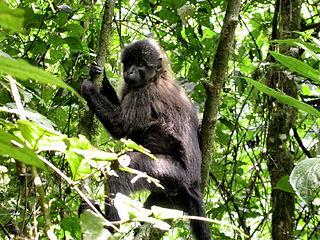Related Research Articles

There are 38 subspecies of Canis lupus listed in the taxonomic authority Mammal Species of the World. These subspecies were named over the past 250 years, and since their naming, a number of them have gone extinct. The nominate subspecies is the Eurasian wolf.

In biology, taxonomy is the scientific study of naming, defining (circumscribing) and classifying groups of biological organisms based on shared characteristics. Organisms are grouped into taxa and these groups are given a taxonomic rank; groups of a given rank can be aggregated to form a more inclusive group of higher rank, thus creating a taxonomic hierarchy. The principal ranks in modern use are domain, kingdom, phylum, class, order, family, genus, and species. The Swedish botanist Carl Linnaeus is regarded as the founder of the current system of taxonomy, as he developed a ranked system known as Linnaean taxonomy for categorizing organisms and binomial nomenclature for naming organisms.

The Integrated Taxonomic Information System (ITIS) is an American partnership of federal agencies designed to provide consistent and reliable information on the taxonomy of biological species. ITIS was originally formed in 1996 as an interagency group within the US federal government, involving several US federal agencies, and has now become an international body, with Canadian and Mexican government agencies participating. The database draws from a large community of taxonomic experts. Primary content staff are housed at the Smithsonian National Museum of Natural History and IT services are provided by a US Geological Survey facility in Denver. The primary focus of ITIS is North American species, but many biological groups exist worldwide and ITIS collaborates with other agencies to increase its global coverage.

Wikispecies is a wiki-based online project supported by the Wikimedia Foundation. Its aim is to create a comprehensive open content catalogue of all species; the project is directed at scientists, rather than at the general public. Jimmy Wales stated that editors are not required to fax in their degrees, but that submissions will have to pass muster with a technical audience. Wikispecies is available under the GNU Free Documentation License and CC BY-SA 3.0.

Soil classification deals with the systematic categorization of soils based on distinguishing characteristics as well as criteria that dictate choices in use.

The crested mangabeys are West African Old World monkeys belonging to the genus Lophocebus. They tend to have dark skin, eyelids that match their facial skin, and crests of hair on their heads. Another genus of mangabeys, Cercocebus, was once thought to be very closely related, so much so that all the species were placed in one genus. However, Lophocebus species are now understood to be more closely related to the baboons in genus Papio, while the Cercocebus species are more closely related to the mandrill. In 2006, the highland mangabey was moved from Lophocebus to a new genus, Rungwecebus.

The black-footed gray langur is an Old World monkey, one of the species of langurs. Found in southern India, this, like other gray langurs, is a leaf-eating monkey.

Heinrich Gustav Adolf Engler was a German botanist. He is notable for his work on plant taxonomy and phytogeography, such as Die natürlichen Pflanzenfamilien, edited with Karl A. E. von Prantl.

The International Committee on Taxonomy of Viruses (ICTV) authorizes and organizes the taxonomic classification of and the nomenclatures for viruses. The ICTV has developed a universal taxonomic scheme for viruses, and thus has the means to appropriately describe, name, and classify every virus that affects living organisms. The members of the International Committee on Taxonomy of Viruses are considered expert virologists. The ICTV was formed from and is governed by the Virology Division of the International Union of Microbiological Societies. Detailed work, such as delimiting the boundaries of species within a family, typically is performed by study groups of experts in the families.
Animal Diversity Web (ADW) is an online database that collects the natural history, classification, species characteristics, conservation biology, and distribution information on thousands of species of animals. The website includes thousands of photographs, hundreds of sound clips, and a virtual museum.
Amphibian Species of the World 6.1: An Online Reference (ASW) is a herpetology database. It lists the names of frogs, salamanders and other amphibians, which scientists first described each species and what year, and the animal's known range.
Mammal Species of the World: A Taxonomic and Geographic Reference is a standard reference work in mammalogy giving descriptions and bibliographic data for the known species of mammals. It is now in its third edition, published in late 2005, which was edited by Don E. Wilson and DeeAnn M. Reeder.
The Catalogue of Life is an online database that provides an index of known species of animals, plants, fungi, and microorganisms. It was created in 2001 as a partnership between the global Species 2000 and the American Integrated Taxonomic Information System. The Catalogue is used by research scientists, citizen scientists, educators, and policy makers. The Catalogue is also used by the Biodiversity Heritage Library, the Barcode of Life Data System, Encyclopedia of Life, and the Global Biodiversity Information Facility. The Catalogue currently compiles data from 165 peer-reviewed taxonomic databases that are maintained by specialist institutions around the world. As of September 2022, the COL Checklist lists 2,067,951 of the world's 2.2m extant species known to taxonomists on the planet at present time.

Stink badgers, also known as false badgers are a genus (Mydaus) of the skunk family of carnivorans, the Mephitidae. They resemble the better-known members of the family Mustelidae also termed 'badgers'. There are only two extant species – the Palawan stink badger or pantot, and the Sunda stink badger or teledu. They live only on the western islands of the Greater Sunda Islands: Sumatra, Java, Borneo in Indonesia, Malaysia and Brunei and on the Philippine island of Palawan; as well as many other smaller islands in the region.
Van Stanley Bartholomew Wallach is an American herpetologist and an expert on blindsnakes and on the systematics, internal anatomy, and taxonomy of snakes. He has contributed to the descriptions of at least 46 species of snakes and has conducted fieldwork on tropical snakes in the Philippines, Nicaragua, and the Democratic Republic of the Congo.
Catalog of Fishes is a comprehensive on-line database and reference work on the scientific names of fish species and genera. It is global in its scope and is hosted by the California Academy of Sciences. It has been compiled and is continuously updated by the curator emeritus of the CAS fish collection, William N. Eschmeyer.

iSpot is a website developed and hosted by the Open University with funding from the Open Air Laboratories (OPAL) network with an online community intended to connect nature enthusiasts of all levels.

The Open Tree of Life is an online phylogenetic tree of life – a collaborative effort, funded by the National Science Foundation. The first draft, including 2.3 million species, was released in September 2015. The Interactive graph allows the user to zoom in to taxonomic classifications, phylogenetic trees, and information about a node. Clicking on a species will return its source and reference taxonomy.

BacDive is a bacterial metadatabase that provides strain-linked information about bacterial and archaeal biodiversity.
MusaNet is a global network of scientists and other stakeholders working on banana genetic resources. Founded in 2011 and coordinated by Bioversity International, it has over 100 individual members representing various banana research institutes and organizations.